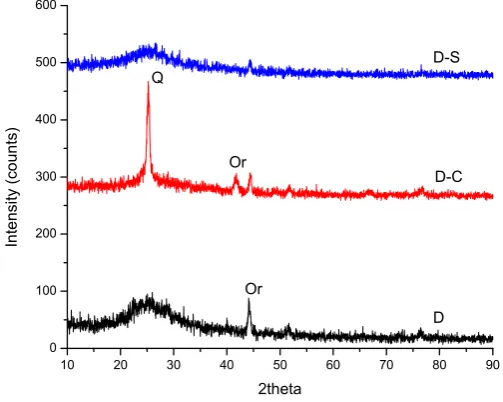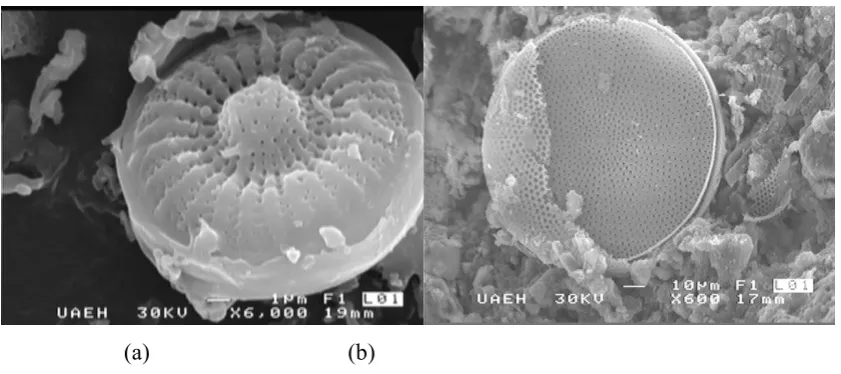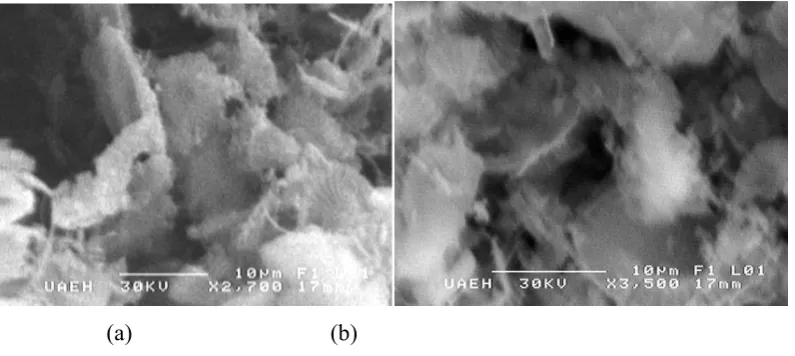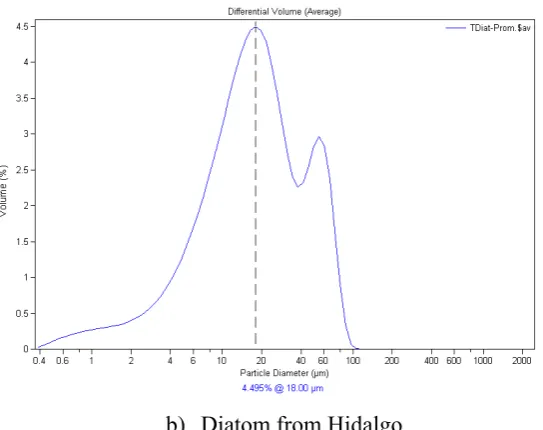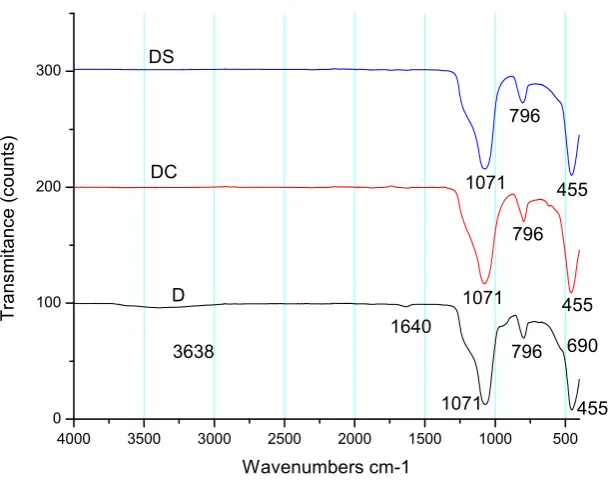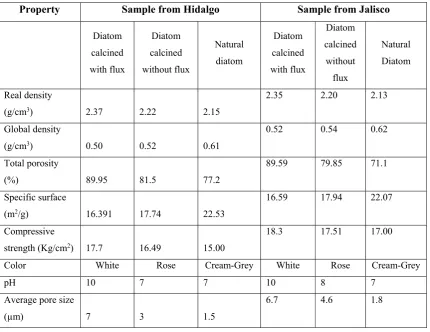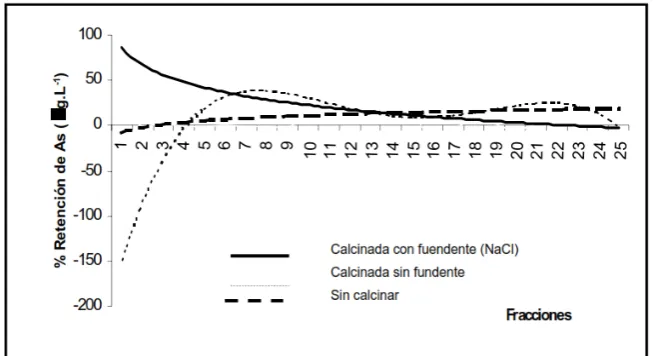Diatoms and Their Capability for Heavy Metals Removal by Cationic Exchange
Juan Hernández-Ávila 1, Eleazar Salinas-Rodríguez 1,*, Eduardo Cerecedo-Sáenz 1,
Ma. Isabel Reyes-Valderrama 1, Alberto Arenas-Flores 1, Alma Delia Román-Gutiérrez 2 and Ventura Rodríguez-Lugo 1
1 Universidad Autónoma del Estado de Hidalgo, Área Académica de Ciencias de la Tierra y Materiales. Carr. Pachuca –
Tulancingo, Km 4.5 s/n, Mineral de la Reforma. Hgo., México. C.P. 42184, México; herjuan@uaeh.edu.mx (J.H.-Á.); mardenjazz@yahoo.com.mx (E.C.-S.); isareyv@hotmail.com (M.I.R.-V.); arenasa@uaeh.edu.mx (A.A.-F.);
ventura.rl65@gmail.com (V.R.-L.)
2 Universidad Autónoma del Estado de Hidalgo, Área Académica de Química en Alimentos. Carretera Pachuca –
Tulancingo, Km 4.5 s/n, Mineral de la Reforma. Hgo., México., C.P. 42184, México; adroman@uaeh.edu.mx
* Correspondence: salinasr@uaeh.edu.mx; Telf. +52-771-717-2000 (ext. 2280)
Abstract
This work shows the physicochemical and mineralogical characterization of diatomites form the Hidalgo and Jalisco States, Mexico. In the case of the mineral from Hidalgo State, this has the following chemical composition; 70.0 % wt. SiO2, 11.63 wt. % Al2O3, 1.95 wt. % FeO, 1.79 wt. % MgO, 2.41 wt. % K2O, 0.85 wt. % CaO and 6.10 wt. % Na2O. On the other hand, the mineral from Jalisco has the following chemical composition; 93.58 wt. % SiO2, 3.03 wt. % Al2O3, 1.81 wt. % FeO, 0.40 wt. % MgO, 0.92 wt. % K2O, 0.11 wt. % CaO and 0.24 wt. % Na2O. For recovery of metals, both minerals got arsenic, silver, lead and nickel recoveries upper to 95 % and lower to 10 % for chromium. According to efficiency of interchange, the mineral from Hidalgo is slightly higher in the case of arsenic, lead and silver; while for nickel and particularly chromium (VI) the efficiency is higher for the mineral from Jalisco.
Keywords: Diatomite; ionic exchange; metals removal; heavy metals
Introduction
microscopic marine algae of unicellular compositions, with varied shapes and sizes. The algae are composed by a transparent cellular wall, with a translucent outer layer of silica (6,7) crystal-like and a inner layer of pectin with a chemical composition of the diatoms walls of 96.5 wt. % de silica and 1.5 wt. % of sesqui-oxides.
Industrially diatom is used in a great variety of fields and has different names depending upon of its purity or the region of origin. Diatoms are widely used as filters in diverse branches of industry, such as in water filters, filters for elaboration of beer and wine, among other processes (3), filler additive, absorbent additive, and soft abrasive (1,3). On the other hand, actually there are few research works related about the use of diatoms for elimination of chemical wastes of recovery of metals from effluents. For this reason this work is related to the capacity of this material to retain heavy metals into is structure.
Methodology
The material used in this work was sampled in the mining region of “El Barqueño” in the state of Jalisco, and the other in the community of “Loma Larga” in the county of Acatlan, in the state of Hidalgo, both in Mexico. For characterization it was necessary to prepare the sample to particle sizes lower than 100 µm, and then was characterized by the following analytical methods: X – Ray Diffraction; which was done in an ENEL Diffractometer model Equinox 200 located at the University Autonomous of the State of Hidalgo (UASH), Mexico and was also used the database MATCH to index the spectra; quantification of contained elements in sample was carried out by Inductively Coupled Plasma Spectrophotometry with an equipment brand Perkin Elmer model 2100 (located at UASH). At the same way, morphology of samples was obtained using an Scanning Electron Microscopy, brand JEOL model JMS 6300 (located at UASH) with a voltage of 30 keV and equipped with an EDS detector.
To determine the capacity of interchange of metals during absorption proofs, it was used a spectrophotometer of Atomic Absorption (AAS). On this late case, we worked with nitrates of Ag+, Ni2+, Zn2+, Pb2+, As3+ and Cr2072-. To verify if there is ionic exchange with the clay present in the diatoms, the sodium concentration in a water – diatom mixture was measured and then the sodium present was compared with another, to which a solution of these metals was added in an average concentration of 4 ppm. For each test set, a calibration curve with patterns from 0.1 to 10 mg/L (including blank), the 4 mg/L solutions were added to the diatom and this was done for two samples of each cation and allowed to stand for one week, after which the corresponding measurements were made (8).
The removal efficiency (Er, amount of cation removed from solution) was calculated using the following formula:
Er=100CoCf Co - (1)
Where Co is defined as initial concentration of metal of interest and Cf is the metal concentration once exposed to diatom. The two samples were then taken and the liquid was evaporated; were added 100 mL of water to the first sample and 100 mL of HCl at 0.1 mol/L to the second sample, allowed to stand for 5 days and the concentration of the metal was measured.
Results and discussion
The principal mineral species identified in the diatoms studied by X – Ray Diffraction are shown in table 1, where the majority specie found is silica, at the same way are present other mineral species in different amounts (Figures 1 and 2). Also in Figure 2 can be seen the spectra of diatom, calcined and natural
Table 1. Mineral species identified in the materials studied
ORIGIN MINERAL SPECIES
Jalisco Silica, Albite, Moscovite, Potassium
Feldspar, Mogonita and Andesite
Feldspar, Mogonita and Andesite
Figure 1. X – Ray spectrum of diatom from the state of Hidalgo, Mexico
10 20 30 40 50 60 70 80 90
0 100 200 300 400 500 600
D-S
D-C
D Q
Or
In
te
ns
ity
(
cou
nt
s)
2theta Or
From chemical analysis done, we found that principal elements present were Si, Al, K, Na, Ca, Fe and Mg, values that associated to their respective oxides (table 2), and represent normal values of high quality diatoms.
Table 2. Chemical composition for diatoms studied.
ORIGIN TREATMENT Element wt. %
SiO2 Al2O3 K2O Na2O CaO FeO MgO TiO
Hidalgo
Natural 70.0 11.63 2.41 6.10 0.85 1.95 1.79 0.50
Calcined 81.50 12.00 2.10 1.45 0.10 1.44 0.48 0
Calcined with Flux
82.00 11.15 1.96 2.82 0.13 1.646 0.51 0
Jalisco
Natural 93.58 3.03 0.92 0.24 0.11 1.81 0.40 0
Calcined 96.39 3.25 0.05 0.23 0.0 0 0.08 0
Calcined with Flux
94.49 2.90 0.7 1.75 0.07 0 0.09 0
On the other hand, it was measured the average size of diatom pore studied, which varies from 1.5µ to 7µ by Scanning Electron Microscopy (both Diatoms). In this way the morphology of this material was found, which can be observed in Figures 3, 4 and 5.
(a) (b)
(a) (b)
Figure 4. Photomicrography of diatom from Hidalgo; (a) Calcined with flux, and (b) Calcined without flux
(a) (b)
Figure 5. Photomicrography of diatom from Jalisco; (a) Calcined with flux, and (b) Calcined without flux
Likewise, in the study of particle size it was obtained a bimodal granulometric curve, that in the first maximum range shows a major percentage of retained material in particle sizes between the range of 12.99 and 22.73 µm for the diatom from Jalisco, and from 12.87 to
Additionally, another maximum range of retained material is observed between particle
sizes in the range of 39.78 to 63.41 μm, showing a retained weight in the range of 2.33 to 2.96 %, for diatom from Jalisco. For diatom from Hidalgo the data obtained were of 39.58 to 63.23 μm for particle size retained with a retained weight of 2.30 to 2.92 %. According the above, we can see that studied diatoms, show majority fine sizes and principally in particle sizes not higher than 40 µm, and it is possible that resting material shows silicified and agglomerated particles (Figure 6).
b) Diatom from Hidalgo
Figure 6. Particle Size; a) diatom from Jalisco, and b) diatom from Hidalgo
Results from IR (Infrared) study showed that studied diatoms have a value of humidity of 4.2 % for the material from Jalisco and 5.4 % for diatom from Hidalgo, which is favorable because with these low values the diatoms have a higher absorption capacity, due to humidity is an important factor that promotes liquid absorption capacity in diatoms. On the other hand, when diatom is calcined, the hydroxyl groups on the mineral surface are lost in the form of water and more silanols groups are exposed (Si-OH), which improves its capacity to absorb liquids.
a) Diatom from Hidalgo
b) Diatom from Jalisco
4000 3500 3000 2500 2000 1500 1000 500
0 100 200 300 455 455 796 796 1071 1071 T ransm itan ce ( count s) Wavenumbers cm-1 D DC DS 3638 1640 1071 796 690 455
Figure 7. IR spectrum of a) diatom from Jalisco, and b) diatom from Hidalgo 7 9 6 4 5 5 10 71 36 38 6 9 0 D S D C D
Wavenumbers cm -1
In table 3 are shown the properties of studied diatoms in their natural state and calcined with and without flux, and t is possible to observe that properties after calcination improves substantially instead that observed for natural mineral.
Table 3. Properties of studied diatoms
Property Sample from Hidalgo Sample from Jalisco
Diatom calcined with flux Diatom calcined without flux Natural diatom Diatom calcined with flux Diatom calcined without flux Natural Diatom Real density
(g/cm3) 2.37 2.22 2.15
2.35 2.20 2.13
Global density
(g/cm3) 0.50 0.52 0.61
0.52 0.54 0.62
Total porosity
(%) 89.95 81.5 77.2
89.59 79.85 71.1
Specific surface
(m2/g) 16.391 17.74 22.53
16.59 17.94 22.07
Compressive
strength (Kg/cm2) 17.7 16.49 15.00
18.3 17.51 17.00
Color White Rose Cream-Grey White Rose Cream-Grey
pH 10 7 7 10 8 7
Average pore size
(µm) 7 3 1.5
6.7 4.6 1.8
Exchange of metals
Table 4. Values of cationic exchange for metals using diatoms (ph 8) .
Metal Initial
concentration
(± 0.004 mg/L)
Final concentration
Diatom from Hidalgo (± 0.004 mg/L)
Initial concentration
Diatom from Jalisco
(± 0.004 mg/L)
Efficiency of exchange
Diatom from Hidalgo
(%)
Efficiency of exchange
Diatom from Jalisco
(%)
Arsenic 5.27 0. 175 0.185 96.67 96.48
Silver 4.28 0.063 0.066 98.52 98.46. Nickel 3.95 0.188 0.180 95.24 95.44 Chromium
(VI)
4.09 3.790 3.710 7.33 9.29
Lead 4.081 0.048 0.049 98.82 98.80
With respect to the exchange with arsenic with the studied diatoms, can be observed that once diatoms are saturated, occurs a liberation of arsenic just like is observed in Figure 8.
Conclusions
1. According to the obtained chemical composition, it is concluded that diatoms are minerals not capable of effecting anionic exchange, but with an adequate activation con be used as anionic exchangers.
2. Likewise, treated diatoms increased its efficiency in filtering processes and can be used in the absorption of liquids due to its high retention capacity and in a major proportion this increases more with a thermic treatment.
3. For the retention of heavy metals, these diatoms showed good results, and the metals can be eliminated as long as they are not in very high concentration or in too acid solutions.
4. So can be concluded that diatoms could be used in the treatment of wastewater contaminated with heavy metals, but in the case of arsenic however, it was observed that once the diatom was saturated with this element occurred a liberation of it to liquors.
References
1. Borgel Espinoza, I. Caracterización del yacimiento de diatomita de loma larga, municipio de Acatlán, Hidalgo y evaluación de sus aplicaciones alternas. (In Spanish), Thesis, 2007.
2. Kadey F. L., 1975, Diatomite, In: Industrial Minerals & Rocks, 4th Ed., Nueva York, pp. 101-115
3. Secretaría de Economía, Perfil de mercado de la diatomite, (In Spanish) 2006, México, Downloaded: may 26th, 2016, http://www.economia.gob.mx/?P=1837&TS=1
4. Juan Hernandez Avila, Fidel Pérez Moreno, Iván Borgel Espinoza, Eleazar Salinas Rodríguez, Caracterización De Diatomitas De Hidalgo, México. Posible Uso Como Adsorbente En La Disminución De Arsénico En Agua Potable, XL Congreso Mexicano de Química, 2005, 38-42,
6. Merchán, W. N., Melo, S. G., & Sánchez, S. M., 2007, Mineralogía y geoquímica de diatomitas (Boyacá, Colombia). (In Spanish) Geología Colombiana, pp. 32, 77.
7. Perez Moreno, F. Dinámica de arsénico en aguas subterráneas de distribuidor general de agua potable de Zimapan, Doctoral Thesis. 2004.
8. Yuan, P; Wu, D.Q.; He, H.P.; Lin, Z.Y., 2004, Applied surface Science, 227, pp. 30-39.
